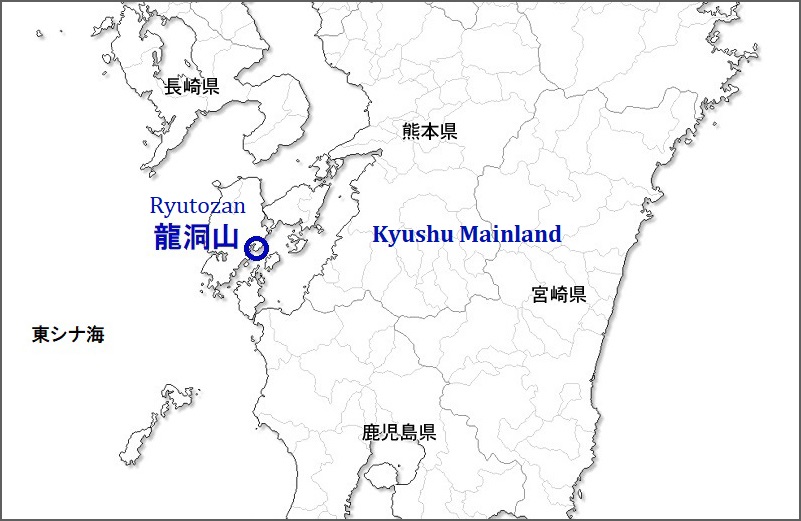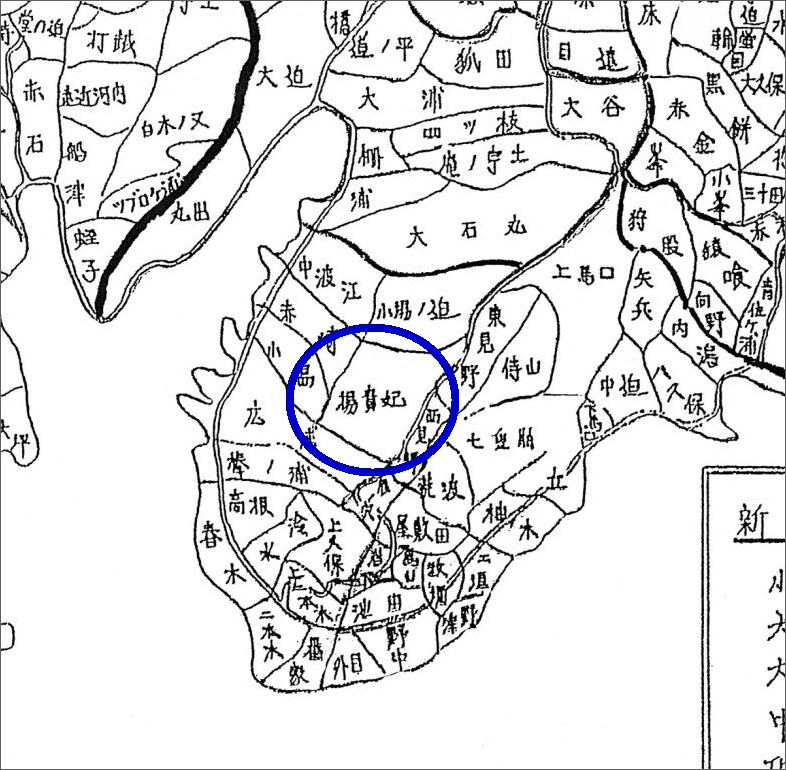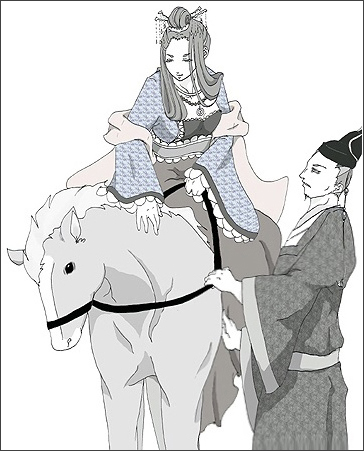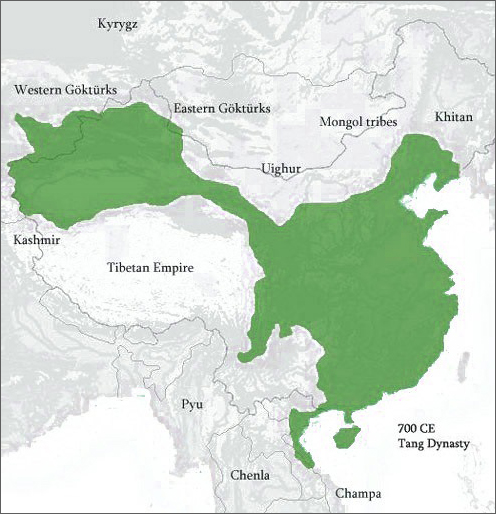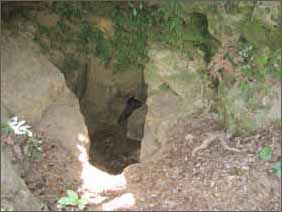|
Yang Guifei Drifted to the Amakusa Islands
- a Legend in Japan -
Chihiro Tanaka (Poet & Novelist)
Norio Iriguchi (Professor Emeritus of Kumamoto University)
1. The Legend of Yang Guifei in Shinwa Town, Amakusa Islands
An ancient map of the Amakusa Islands in Kumamoto Prefecture shows the ancient place name "Yang Guifei" in the center of the Ryutozan (Mt. Ryuto) Peninsula in the town of Shinwa (now Amakusa City), Amakusa County. These ancient place names have been used in some parts of Japan since the Heian period (794-1192). There are legends around the Ryutozan Peninsula about a woman who drifted in from a foreign country a long time ago.
More than 1,200 years ago, a mansion was discovered placed on top of a mountain on the Ryutouzan Peninsula in the Amakusa Islands. A woman lived there. She was so beautiful that the villagers were afraid of her. One summer, the village was struck by a plague. She brought Chinese medicine from the Tang Dynasty and gave it to the villagers, saving their lives. The villagers respected her. She called herself "Yang Guifei" and confided to the villagers that she was waiting for a messenger from His Majesty to take her back to the Tang Dynasty. One day, the sky suddenly became clouded and a thunderstorm rang out, causing a huge dragon to thunder up the mountains of the Ryutozan Peninsula. When the villagers tried to visit her, she had gone with the dragon to some high place. Her house was also gone. Only a small bag of perfume was left there. The place where she lived became known as "Yang Guifei."
This is the legend of Yang Guifei, a legend from the town of Shinwa in the Amakusa Islands. There is a deep cave on top of the mountain, which is suspected by the villagers to be the old lair of the dragon. The name "Ryutozan" means the mountain of the dragon's cave.
In Japan, there was a theory (or rumor) during the Edo period called the "Yoshitsune-Genghis Khan Theory." The theory was that Yoshitsune Minamoto (1159-1189), the great Japanese tragic hero, traveled to the continent and became Genghis Khan (1162-1227). This rumor was due to fondness for Yoshitsune, and was started by prominent scholars such as Razan Hayashi, Hakuseki Arai, Mitsukuni Tokugawa and Philip F. von Siebold. However, the "Yoshitsune-Genghis Khan Theory" does not exist in the country of Mongolia. According to the official Mongolian history books, "Yuan History," "Mongolian Secret History," and "Jami al-Tawarikh," Genghis Khan was born as Temujin, the son of his father Yesugei Baghatur and his mother Hoelun. The "Yoshitsune-Chingis Khan theory" has been denied with those hard evidence that is positive Mongolian history.
On the other hand, there is a legend in modern China that Yang Guifei escaped from the Tang Dynasty during the time of the An Lushan Rebellion and went to Japan. According to the "New Book of the Tang Dynasty," an authentic history of the Tang Dynasty, only a sachet of Yang Guifei's perfume was found a year after the tomb in which she was supposed to be buried (in 756). The basis for this legend is that the official record of Yang Guifei's death was so unclear that the theory of a voyage to Japan could not be ruled out. Is the legend of Yang Guifei in the Amakusa Islands true or false? Take a short trip to verify the legend. 2. Ryutozan Peninsula
Route 266 in Kumamoto Prefecture runs south from the Uto Peninsula through the Pearl Line Bridge to Kamijima Island in the Amakusa Islands. Route 266 goes further down to Shimojima Island. The city of Amakusa is located on Shimojima. A few kilometers south of the city on Prefectural Road 26, you will see Miyajiura Bay. There, pearls are farmed in the sea. The hill near the bay is Ryutozan, 317 meters above sea level. Ryutozan is located on a peninsula at the eastern end of Shimojima of the Amakusa Islands. The Yatsushiro Sea stretches out beautifully to the east of the Ryutozan Peninsula. The Yatsushiro Sea is a calm inland sea, as shown in the photo, and the other side of the sea is the mainland of Kyushu. To the west of the Ryuzusan Peninsula is the Amakusa Islands covered in a green forest. Near the Peninsula, on the shore of Shimojima, there is an old brewery.
On the east side of the Yatsushiro Sea, there is a 40-kilometer long active fault called Hinagudanso, which is located at the bottom of the Yatsushiro Sea. Along this active fault, the seafloor of the Yatsushiro Sea is displaced to the north and the mainland Kyushu is displaced to the south by 1 millimeter per year. Geologists who have studied the seafloor of the Yatsushiro Sea have discovered many faults running north and south, and believe that the Yatsushiro Sea was formed by the sinking of land. About 110,000 years ago, the western side of mainland Kyushu sank, creating the Yatsushiro Sea. Before that time, the Kumagawa River on mainland Kyushu flowed to what is now the Amakusa Islands. The Amakusa Islands have a pebble layer that was once part of the Kumagawa riverbed on mainland Kyushu. According to the Japanese official history of "Shoku Nihongi," a young girl believed to be 14 years old was washed ashore from Tang China on November 13, 778, at Nishinakajima Island, Amakusa County (now Nagashima Island, Izumi County, Kagoshima Prefecture). She was Princess Kijo Fujiwara, a daughter of Kiyokawa Fujiwara (nephew of Japanese Empress Komyo), who emigrated to Tang China in 752 under Emperor Xuanzong, and married a Chinese woman. After Kiyokawa's death, on November 5, 778, Kijo boarded a Japanese envoy ship and attempted to sail to Japan to see her father's country. However, on the fourth day, the ship was hit by a storm and was wrecked. Strapped to the bow, she was swept out to sea for 6 days, and finally landed at Nagashima Island, where she was rescued by the villagers. From the Ryutozan Peninsula, you can see Nagashima Island up close to the south. 3. When the Japanese Learned of the An Lushan Rebellion and Fall of Chang'an?
Emperor Xuanzong of the Tang Dynasty (reigned 712-756) sought to reign with distinction by reforming the tax system and introducing the jiedushi system for local armies and finances. The golden age of the Tang Dynasty was known as the "Kaiyuan Era." However, he was too enchanted by the beauty of Yang Guifei and did not respect the sovereignty of the country, leading to the An Lushan (705-757) Rebellion. For this reason, Yang Guifei is known as the "Beauty of the Nation's Perdition" and is included among the "Four Great Beauties of Ancient China" - Xi Shi, Wang Zhaojun, Diaochan, and Yang Guifei.
According to the authentic Japanese history of the Shoku Nihongi, Tamori Ono was sent as the ambassador to the Balhae Kingdom (a major power existing around present-day Vladivostok) in 758. He returned immediately to report to the Imperial Court on the outbreak of the An Lushan Rebellionb and the fact that Chang'an, the capital of the Tang Dynasty, had fallen to the Yan Dynasty. This report caused the Japanese Imperial Court to fear an invasion by the Yan Dynasty and ordered the Dazaifu of Kyushu, the government office with jurisdiction over Kyushu, Iki, and Tsushima Islands, to be on high alert. That was the first record of the Rebellion and the fall of the Tang Dynasty's capital, Chang'an. In 806, half a century after the An Lushan Rebellion, the Tang Dynasty's Bai Juyi (772-846) composed a long poem, "Song of Everlasting Regret." This was the year that Saicho and Kukai, the Japanese Buddhist monks, returned from the Tang Dynasty as the eighteenth envoy. Bai Juyi wrote the story of Emperor Xuanzong and Yang Guifei so beautifully that it had a strong influence on Japanese literature from the Heian period onward. In the "Kiritsubo" volume of the "Tale of Genji" by Lady Murasaki Shikibu (973-1025), the description of the tragic love between the emperor and his lover Kiritsubo was reminiscent of Bai Juyi's "Song of Everlasting Regret." 4. Were Villagers of the Amakusa Islands Able to Create the Legend of Yang Guifei?
The Amakusa Islands have long belonged to the cultural sphere of the Nagasaki-Shimabara Peninsula rather than Kumamoto, and have had a high level of culture since the Middle Ages. For the first time in Japan, the Western technology of letterpress printing came down to the Amakusa Islands. The Gutenberg printing press was brought back from Europe by the Tensho Embassy of a quartet of Christian boys and installed in 1591 at the Collegio, a Christian school of the Society of Jesus in the town of Kawaura in the Amakusa Islands. It is estimated that 1,500 books were printed at the Collegio each year for seven years. The ancient Greek Aesop's Fables was first introduced to the Amakusa Islands in Japan in 1593 as "ESOPO NO FABVLAS". It is believed to have been translated from Latin into Japanese by Jesuit missionaries and printed in Roman script. The book was further published in Japanese letters in the early Edo period as the "Fables of Isoho." After the Shimabara Rebellion (1637-1638) by the Christians, the persecution of the Christians in Japan became so severe that the Tokugawa shogunate sent prominent Buddhist intellectuals to the Amakusa Islands as a cultural policy. Throughout its long history, the intellectual level of the villagers of the Amakusa Islands was quite high. At the latest, after the Shimabara Rebellion, they were probably aware of Bai Juyi's "Song of Everlasting Regret" and the story of Emperor Xuanzong and Yang Guifei. However, the ancient place name "Yang Guifei" could be traced back to the Muromachi Period (1337-1573) or even Heian Period (794-1192). Kumamoto Prefecture was called "Higo Han" under the Tokugawa Shogunate. Each han was allowed only one castle. Nevertheless, in Higo Han, there were two castles in the towns of Kumamoto and Yatsushiro. The Yatsushiro Castle had two important missions. One mission was to watch Satsuma Han (present Kagoshima Prefecture). Satsuma was a powerful warlord enough to overthrow the Tokugawa central government in the future. If Yatsushiro Castle was to be destroyed by an army from Satsuma, a messenger on horseback could quickly ride north to Kumamoto Castle and warn them. This would give the garrison at Kumamoto Castle time to prepare to fight the advancing army from Satsuma. Another mission of the Yatsushiro Castle was to watch a foreign ship arriving. Foreign ships were found in the Yatsushiro Sea so often from ancient through modern times. Suppose there was a woman from China living on the Ryutozan Peninsula. She was very knowledgeable about medicinal herbs and had saved the lives of the villagers. The more the villagers looked at her, the more handsome she must have looked. No wonder the villagers looked up to her and believed that she was Yang Guifei's reincarnation. It is said that the place where she lived was called "Yang Guifei." The legend of Yang Guifei of the Amakusa Islands may have been artificially created with reference to facts. However, it is of important interest to verify historically and scientifically whether the legend of Yang Guifei in the Amakusa Islands is based on historical facts. 5. Yang Guifei
Yang Guifei was the beloved consort of Emperor Xuanzong (685-762) of the Tang Dynasty in the last years of his life. She was known as a rare beauty. Yang Guifei's surname was Yang, and her given name was Yuhuan. She was from Shu County (present-day Sichuan Province and its environs). Her father was an official of the county and she was from a good family. A good family at that time was not allowed to produce criminals, doctors, priestesses, artisans, merchants and beggars."Guifei" was not her name, but rather her status as the emperor's consort. Bai Juyi (772-846), in his "Song of Everlasting Regret," describes Yang Guifei in the following way; "The golden jewels swayed slowly as she walked with her dark hair and flowery face. They spent the spring night under the warmth of the hibiscus canopy. The sweet night was too short, and they rose after the sun had risen high. From that day forward, His Majesty missed the court every morning. She spent her days pleasing the Emperor and accompanying him always. In the spring she accompanied the Emperor on his outings and shared his bed every night. All three thousand beautiful women in the palace were ignored. She was the only one who enjoyed the royal favor." According to the "New Book of Tang," an authentic history, Yang Guifei was skilled in music and dance. According to the "Unofficial Biography of Yang Guifei" written during the Song Dynasty, her stringed instruments were a gift from Shu County, and the string was made of raw silk given from abroad. Bai Juyi says that Yang Guifei was a master of "whirling dance of the Central Asia." She wore a tropial perfume called "Borneol." Yang Guifei appears to us to be a beautiful woman at the mercy of fate. But in reality, she was a jealous woman, or rather a strong living woman. Close to Emperor Xuanzong, there was another consort named Jiang Cai-Ping. Jiang Cai-Ping was probably a fictitional character. Before Yang Guifei, all of Emperor Xuanzong's affections was directed towards Jiang Cai-Ping. Emperor Xuanzong was still attracted to Jiang Cai-Ping, even after Yang Guifei became his consort. One day, the Emperor secretly called Jiang Cai-Ping to the Palace. Yang Guifei rushed into the Palace in the evening and asked the Emperor where Jiang Cai-Ping was. The Emperor had hidden Jiang Cai-Ping behind the drop-curtain, but Yang Guifei was convinced that Jiang Cai-Ping was in his bedroom and told the Emperor to do some government business while she was waiting for the Emperor in her room. Emperor Xuanzong must have been attracted to this exclusively strong personality of Yang Guifei. Yang Guifei seemed to be very good at dealing with men, and she was not second even to Cleopatra in Egypt. One day Yang Guifei was sent out to her residence from the Palace because of the Emperor's displeasure. After some time, a messenger from the Emperor came to visit her. She handed the messenger a bundle of her hair with a message, "My fault is worthy of the death penalty. All my property, except my body and hair, has been given to me by His Majesty. As a farewell gift, I will give this to His Magesty." Emperor Xuanzong was embarrassed when he saw the bundle and immediately called Yang Guifei back to the Palace. Wherever Emperor Xuanzong went out, Yang Guifei followed. When she ride her horse, Gao Lishi (684-762) took over the reins and handed a whip to her. Gao Lishi was a eunuch and known to be an excellent tactician. She had hundreds of craftsmen of silk goods and ornaments exclusively employed for her. She received many gifts of goods from many people, and local officials who presented her with valuable goods were specially promoted. The response of governmental officials to a request from the Yang family was like an imperial edict from His Majesty. Messengers with gifts for the Yang family from all quarters lined up in front of the gates of their residences.
Albert Herrmann, "The Tang Dynasty, Boundaries
of 700 A.D." 6. Japan Viewed from the Tang Dynasty
Japan had sent Mitasuki Inugami to the Tang Dynasty as the first envoy in 630. Japan was also at war with the Tang Dynasty, but the Tang Dynasty in alliance with the Silla Kingdom defeated the combined forces of Japan and the Baekje Kingdom at the Baek River in Korea on October 5, 663. The number of Japanese ships defeated was 800 and the number of Tang ships was 170. The Tang ships were much larger than the Japanese ships. The Baekje Kingdom fell into ruin at that time. The Japanese Emperor Tenji sent envoys to the Tang Dynasty in 665, 667, and 669. According to the "Book of Tang," an authorized history of the Tang Dynasty, in 703, Mahito Awata brought tribute from Japan to the Zhou Dynasty of Wu Zetian. It records that Mahito was a thoughtful and intelligent man who could read the Chinese classics. Wu Zetian invited Mahito to her palace banquet and gave him an official position within the Dynasty. In 704, Mahito returned home with Japanese hostages captured at the Battle of Baekgang (663). During the reign of Emperor Xuanzong (712-756), a few Japanese missions were sent to Tang China. Nakamaro Abe, who emigrated from Japan in 717, was so pleased with his life in Tang China that he stayed there until his death. He passed the civil service examination. His Chinese name was Chao Heng. He took several government positions and rose to the position of Governor of Annam. Envoys to Tang China during the Reign of Emperor Xuanzong (712-756)
After praying for maritime safety at the Sumiyoshi Grand Shrine, the group departed from Suminoe-no-tsu International Port (now Sumiyoshi-ku, Osaka City). They crossed the Seto Inland Sea, Nanotsu (now Chuo-ku, Fukuoka City), Bonotsu (now Minamisatsuma City, Kagoshima Prefecture), Amami Oshima Islands, and the Akonawa Islands (now Okinawa Prefecture) before crossing the East China Sea. The wooden ships were vulnerable to the broadening of the waves and capsizing was very common. Four ships were dispatched at a time, each with about 100 people on board. They landed at Suzhou or Mingzhou at the estuary of the Yangtze Chang. To the Tang people at that time, Japan was immediately located in the lower reaches of the Yangtze Chang.
7. The End of Yang Guifei
The prime minister Yang Guozhong, a cousin of Yang Guifei, became seriously opposed to An Lushan, a jiedushi, who was native from the Central Asia.
In 755, the An Lushan Rebellion broke out and Luoyang the second largest city of the Tang Dynasty was destroyed by their Yan Dynasty. Emperor Xuanzong left Chang'an, the capital city of the Tang Dynasty, and took refuge toward Shu Province of the Yang family. The party consisted of about 2,000 people, including Emperor Xuanzong, Yang Guifei, Prince Li Heng who was the next Emperor Suzong, Gao Lishi, Yang Guozhong, sisters of Yang Guifei, Chen Xuanli, the Imperial Commander General and his soldiers, eunuchs and followers. Chen Xuanli was a faithful retainer to Emperor Xuanzong since he was still a prince. It was recorded that when Emperor Xuanzong attempted to visit Yang Guifei's sister, Chen Xuanli advised him not to go out from the Palace in such an easy way without an imperial edict. According to "Zizhi Tongjian," when Emperor Xuanzong left Chang'an, the capital city, he persuaded Yang Guozhong not to burn the treasures because An Lushan would plunder villages instead. When Emperor Xuanzong has crossed the Wei River Bridge, he persuaded Yang Guozhong not to burn the bridge to prevent enemies because civilian people would want to use the bridge to escape from Chang'an. They were in Mawei, a courier station, which was 50 kilometers to the west of Chang'an. They were short of food and soldiers were irritated. According to the "Unofficial Biography of Yang Guifei," Chen Xuanli was afraid of a riot of soldiers. When representatives from the Tibetan Empire gathered around Yang Guozhong and demanded food, the soldiers shouted that Yang Guozhong was raising treason with the Tibetans, and the soldiers murdered him. They killed also Yang Guifei's sisters. Chen Xuanli had no choice but to advise Emperor Xuanzong to kill Yang Guifei. According to the "New Book of Tang" and "Unofficial Biography of Yang Guifei," His Majesty answered, "Yang Guifei was in the palace and not related to the treason of Yang Guozhong," and tried not to allow to kill her for anything all the world. However, following an advice of Gao Lishi, Emperor Xuanzong parted from Yang Guifei and allowed Gao Lishi to order Yang Guifei to commit suicide. It was recorded that Gao Lishi strangled Yang Guifei with white silk in a temple under a pear tree. It was also recorded that a tribute of litchi fruits, Yang Guifei's favorite, arrived at that time from a southern country. Her corpse had been covered with an embroidered cloth in purple and her death was confirmed by Chen Xuanli. It was recorded that her corpse was buried a few kilometers apart to the west from Mawei. The riot of soldiers was put down. It was 15th July of 756, and Yang Guifei was 37 years old. 8. The Truth of the End of Yang Guifei
No one had seen Yang Guifei's corpse. Not even Emperor Xuanzong had seen her corpse. His confidants Gao Lishi and Chen Xuanli had only announced that they had seen her corpse. In fact, the last moment of Yang Guifei was hidden from the public attention by those two people, Gao Lishi and Chen Xuanli. Gao Lishi 72 was a man of tactics who had given his life for Emperor Xuanzong. Chen Xuanli 66 was the Imperial Commander who had given his life for Emperor Xuanzong also for his life. All they had to do was to put down the riot of soldiers. It would never pay for them to kill Yang Guifei. Hadn't Gao Lishi asked Chen Xuanli for his help to have Yang Guifei escape abroad? The plan could have been viable with their confidential agreements. First, Gao Lishi took Yang Guifei into a temple of no signs of life under a pear tree, announcing that she wanted to worship the Buddha. Chen Xuanli prevented soldiers from bursting into the temple as lese majesty. Then, Gao Lishi announced that he had strangled Yang Guifei there. Gao Lishi, having shaded her nose with his hand, called out to Chen Xuanli, "Imperial Commander, Esquire!" Her corpse had been covered with an embroidered cloth in purple. Chen Xuanli alone raised her head and said, "Good." When a new coffin for her was delivered there, Gao Lishi answered that her corpse had already been secretly buried by eunuchs a few kilometers away from Mawei to be protected from disgracing by rude soldiers. It can't be denied that Yang Guifei was able to escape abroad under the protection of eunuchs and Chen Xuanli's trusted soldiers. When Emperor Xuanzong was returning to Chang'an from Shu Province in December of the next year, he was afflicted by a strong sense of forfeiture for Yang Guifei. According to the "New Book of Tang," he secretly sent eunuchs to open the tomb where Yang Guifei had been supposed to be buried. Only a sachet of her perfume was found. The eunuchs submitted the sachet to Emperor Xuanzong. If Yang Guifei had escaped abroad, then where did she go? The Tang Dynasty was a great empire keeping company with over 40 countries. But not all countries were necessarily friendly. Since the outbreak of the An Lushan Rebellion, the Tang Dynasty had been weakend. On the frontier, the Uyghurs Empire, the Tibetan Empire, and Khitan were growing stronger. The Tibetan Empire, taking advantage of the An Lushan Rebellion, was invading into the Tang Dynasty to occupy Hexi and Longyou. Therefore, if Yang Guifei was sent to the Tibetan Empire, she would have been killed there. On the other hand, in the Korean Peninsula, the Silla Kingdom defeated the Tang forces (the Silla-Tang War) and unified the entire peninsula. Therefore, it was aslo dangerous to send Yang Guifei to the Korean peninsula. Meanwhile, in Japan, the Taiho Code, the administrative reorganization that Japan had learned from the Tang Dynasty, had been in effect since 702, and Japan had been overpowered by the emperor throughout the country. In the capital city, Nara, the "Tempyo Culture" was in full bloom. Japan would have been the most promising country for Yang Guifei to go. This is the source of the legend in modern China that Yang Guifei escaped from the Tang Dynasty and went to Japan during the An Lushan Rebellion. 9. Where was the Celestial Mountain above the Sea in the "Song of Everlasting Regret?"
Gao Lishi followed Emperor Xuanzong to Shu Province, where he was promoted to "Duke of Qi" for his contribution of many years to the Tang Dynasty.
In July of 756, Prince Li Heng ascended the throne as Emperor Suzong, and Emperor Xuanzong
became abdicated. In January of 757, An Lushan was killed by his son An Qingxu. Emperor Suzong won back the cities
Chang'an and Luoyang with reinforcements from Uyghur. Emperor Suzong entered Chang'an in
October 757, and Xuanzong entered Chang'an in December 757.
According to Bai Juyi's "Song of Everlasting Regret," His Majesty Xuanzong prevailed upon a Taoist priest to look for her. According to Bai Juyi, Yang Guifei was far away on a celestial mountain above the sea. "The monk suddenly heard about a mountain of celestial beings that was above the sea. The mountain was in a vast expanse." The celestial mountain above the sea in the "Song of Everlasting Regret" must have been (1) above the sea far from the Tang Dynasty, (2) an island in a vast expanse, and (3) a mountain. Although the real world cannot be compared to the romantic world of the "Song of Everlasting Regret," the mountain of the Ryutozan Peninsula seems to meet all three conditions. In the volume of "Konohana-wa" of "Makura-no-Soshi (the Pillow Book)" by Lady Sei Shonagon (966-1025), she depicts pear blossoms so beautiful taking the visit of the Taoist priest in her mind as; "A twig of pear blossoms wet with spring rain looks as if it were Yang Guifei with tears trickling down her cheeks to see the messenger from His Majesty." 10. Was it Possible for Yang Guifei to Sail from Tang China to the Amakusa Islands?
The Hwang Ho or Yellow River, originating in the Bayan Har Mountains in Qinghai Province in western China, flows through northern provinces of China to the Bohai Sea. "Ho" was a proper noun for Hwang Ho. It is estimated 5,500 kilometers long and has a total watershed area of 740,000 square kilometers (twice the area of Japan). It flows 5 kilometers
close to Mawei. Yang Guifei could have traveled through the Hwang Ho to the coast of the Bohai Sea in a short time. The Chang Jiang flows for 6,400 kilometers from the glaciers on the Qinghai-Tibet Plateau eastward across southwestern, central and eastern China before emptying into the East China Sea. The estimated basin area is 1,800,000 square kilometers (almost 5 times the area of Japan). The lower course is known as the Yangtze Chang. It has a stream tributary 80 kilometers close to Mawei. Yang Guifei may have traveled through the Yangtze Chang to the coast of the East China Sea in a short time. The Grand Canal is the longest canal or man-made river in the world. It is 1,800 kilometers long. Starting in Beijing, it passes through the eastern region of China to the city of Hangzhou, crossing Hwang Ho and Yangtze Chang. The Grand Canal had been completed during the Sui Dynasty (589-618). Yang Guifei was also able to travel through the Grand Canal to the shores of the East China Sea. In recent years, the issue of many foreign articles washing ashore in the Amakusa Islands has become a topic of interest. According to the report from the Ministry of Environment of Japan, the manufacturing countries of plastic (polyethylene terephthalate) bottles which were washed ashore on the coast of Reihoku Town in the Amakusa Islands were investigated. Reihoku Town is located in the western part of the Amakusa Islands. The total 73 bottles collected on 5 occasions were; Japan 39%, China 23%, Taiwan 10%, and Korea 1%, and unknown 27%. The investigation revealed that Chinese articles can indeed be drifted ashore in the Amakusa Islands. The following shows typical ocean currents around the Kyushu and Okinawa Islands in mid-July. (Japan Meteorological Agency)
The red markings indicate the location of the Ryutozan Peninsula
in the Amakusa
Islands. The arrows and colors indicate the speed and direction of the current.
1 knot (kt) = 0.5 meter/second. The blue area is where the strong current is. The Japan Current is distinguishable.
Japan Meteorological Agency updates the chart often by analyzing data
from satellites, ships, and buoys. Clearly, there are currents from China
to the Amakusa Islands. The strong currents are typical in mid-July, which seems to be the easiest time to navigate from Tang to the Amakusa Islands. The distance from the estuary of the Yangtze Chang to the Amakusa Islands is 800 kilometers. The velocity 2 kt is the speed at which a person is walking slowly. The speed of a sailing ship is 4 - 8 kt. According to the report from the Ministry of Environment of Japan, a few simulation results are presented as follows;
The drifting courses from China
to the Amakusa islands are visually depicted. On November 13, 788, Fujiwara Kijo, daughter of Japanese envoy Kiyokawa Fujiwara , drifted ashore at Nishinakajima, Amakusa County (present-day Nagashima, Izumizu County, Kagoshima Prefecture). She had sailed for four days on a ship from China (the return ship of the Japanese delegation), and after the ship had collapsed badly, she drifted out to sea for 6 days. This shows that it is possible to sail from Tang to the Amakusa Islands in five days in a slow sailing ship of 4 kts. Even a raft without a sail could drift from Tang to the Amakusa Islands in 20 days with only 1 kt of current. The Tang Dynasty was also a naval empire with a large number of warships. battleships. Yang Guifei and her followers could have been able to sail to the Amakusa Islands with an edict of Emperor Xuanzong. If she sailed to the Amakusa Islands on a battleship, many people and commodities could have been transported to build a mansion on top of the mountain on the Ryutozan Peninsula to maintain her livinfe thereafter. 11. The End of Emperor Xuanzong
The An Lushan Rebellion lasted until 763 by his
successor Shi Siming.
Emperor Xuanzong was asked by Emperor Suzong of his responsibility of the
national crisis of the Tang Dynasty brought about by being fascinated by
his beauty Yang Guifei too strongly to pay attention to his sovereignty
over his country and confined to the palace until his death on 3rd May
of 762. Gao Lishi, known to have wailed to know of the death of Xuanzong,
died in the same year 762. The 13th envoy from Japan to the Tang Dynasty attempted to enter the Dynasty in 759 through the Bohai Sea but returned home due to the An Lushan Rebellion. The 14th (in 761) and 15th (in 762) envoys were abandoned and cancelled. 12. Was Yang Guifei Knowledgeable about Herbal Medicine?
Yang Guifei was raised gently in a good family and was good at music and dancing. She wouldn't have had any practical knowledge like pharmacology.
However, pharmacology had been highly developed in China since the Zhou and Han dynasties. If Emperor Xuanzong had promised to bring Yang Guifei back from Japan in the future, he would have given her many different Chinese medicines that she could use.
According to the legend of Yang Guifei in the Amakusa Islands, it was
a summer when a plague struck the village around the Ryutozan Peninsula.
Pueraria decoction and ginseng decoction (written by Zhang
Zhongjing in "Shang Han Lun" would have been the most
effective in treating fever caused by food poisoning. Ephedra decoction (also described in "Shang Han Lun") is
expected to be as effective in treating the symptoms as the modern antiviral drug
Tamiflu (a trade name of F. Hoffmann-La Roche, Ltd.). (Yomiuri Newspaper 8th May 2009)
13. Was it Possible for Yang Guifei to Disappear into the the Sky with a Dragon?
According to the legend of Yang Guifei in Shinwa Town
of Amakusa Island, one day the sky suddenly became cloudy with
flashes of lightning, and a huge dragon soared over the mountain of the Ryutozan
Peninsula. When the villagers tried to visit her,
she had gone away with the dragon. Her house wa. s also gone.
Only her sachet of perfume was left there. In 663, after defeated by the Tang Dynasty at the Battle in Korea, the Imperial Court of Japan sent sakimori soldiers to Dazaifu, the government office in Kyushu. This was a garrison to guard the coast in fear of the a Tang invasion. Sakimori soldiers were drafted in the eastern region in Japan (east of present-day Shizuoka Prefecture) and were also drafted in Kyushu from 757. The following year, 758, the Imperial Court, learning of the outbreak of the An Lushan Rebellion and the fall of Chang'an, ordered Dazaifu to increase its vigilance. If the Tang emperor's consort had been living on the Ryutouzan Peninsula in Amakusa Islands, waiting for messengers from the emperor, Dazaifu would have been in a position to know the important fact at once. The new emperor of the Tang Dynasty, Emperor Suzong, had inherited the national crisis of former emperor Xuanzong (An Lushan Rebellion) and was in the midst of the war. Emperor Suzong would have known that Yang Guifei's tomb had been emptied. Emperor Suzong would have sniffed out the secret in his palace and was in a position to secretly send a warship to the Lyutozan Peninsula in the Amakusa Islands to pursue Yang Guifei. On the other hand, the illustration of the giant dragon in the legend o f Yang Guifei in Shinwa Town in the Amakusa Islands is reminiscent of the scene of a great tornado during Japan's typhoon season. According to the database of Japan Meteorological Agency, there had been 15 tornadoes in Kumamoto Prefecture from 1963 through 2009. Tornadoes are classified according to the "Fujita Scale" criteria (Professor Tetsuya Fujita of Chicago University). Most of the tornadoes that occurred in Kumamoto Prefecture were F0 or F1, However, one of the 15 tornadoes was classified as an F2 tornado. The location was Hondo City in the Amakusa Islands (05:15, October 12, 1975). Hondo City is now Amakusa City. According to the definition of the Fujita scale, an F2 class tornado can cause the following damages; "Big damages. Roofs of houses could be blown off with walls. Mobile houses are destroyed. Trains run off the rails. Large trees are broken or blown down. Light objects could fly like missiles. Cars would roll around." It can't be denied that such a large tornado had taken place on the Ryutozan Peninsula of Shinwa Town in the Amakusa Islands about 1,200 years ago. The tornado could have swallowed Yang Guifei into the sky and left the legend of Yang Guifei in the Amakusa Islands.
The legend of Yang Guifei in the Amakusa Islands
could have been based on the real facts. It could also have been artificially created.
However, the legend of Yang Guifei, who escaped from
the Tang Dynasty to Anakusa Islands during the time of the An Lushan Rebellion, gives us great and fantastic dreams.
With this in mind, we set off from the Ryutozan Peninsula in the Amakusa Islands. References
| |||||||||||||||||||||||||||||||||||||||||||||||||||||

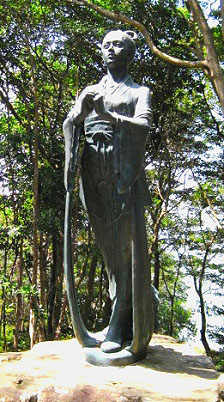 Yang Guifei on the Ryutozan Peninsula
Yang Guifei on the Ryutozan Peninsula